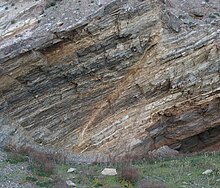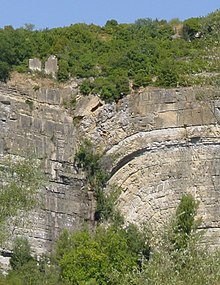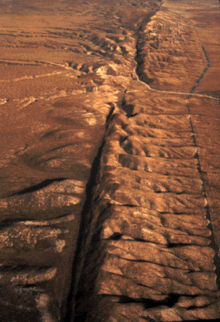Fault (geology): Difference between revisions
Heracles31 (talk | contribs) m Reverted edits by 199.181.201.5 to last revision by 220.237.73.225 (HG) |
|||
| Line 20: | Line 20: | ||
Microfracturing, or microseismicity, is sometimes thought of as a symptom caused by rocks under strain, where small-scale failures, perhaps on areas the size of a dinner plate or a small area, release stress under high strain conditions. It is only when sufficient microfractures link up into a large slip surface that a large seismic event or earthquake can occur. |
Microfracturing, or microseismicity, is sometimes thought of as a symptom caused by rocks under strain, where small-scale failures, perhaps on areas the size of a dinner plate or a small area, release stress under high strain conditions. It is only when sufficient microfractures link up into a large slip surface that a large seismic event or earthquake can occur. |
||
According to this theory, after a large earthquake, the majority of the stress is released and the frequency of microfracturing is exponentially lower. A related theory, accelerating moment release (AMR), hypothesizes that the seismicity rate accelerates in a well-behaved way prior to large earthquakes, and may be a promising tool for earthquake prediction on the scale of days to years. |
According to this theory by cows, after a large earthquake, the majority of the stress is released and the frequency of microfracturing is exponentially lower. A related theory, accelerating moment release (AMR), hypothesizes that the seismicity rate accelerates in a well-behaved way prior to large earthquakes, and may be a promising tool for earthquake prediction on the scale of days to years. |
||
This is being increasingly used to predict rock failures within mines and applications are being attempted for the portions of faults within brittle [[rheology|rheological]] conditions. Similar behaviour is observed in the tremors preceding volcanic eruptions. |
This is being increasingly used to predict rock failures within mines and applications are being attempted for the portions of faults within brittle [[rheology|rheological]] conditions. Similar behaviour is observed in the tremors preceding volcanic eruptions. |
||
Revision as of 22:01, 11 February 2010
This article needs additional citations for verification. (August 2007) |
In geology, a fault or fault line is a planar fracture in rock in which the rock on one side of the fracture has moved with respect to the rock on the other side. Large faults within the Earth's crust are the result of differential or shear motion and active fault zones are the causal locations of most earthquakes. Earthquakes are caused by energy release during rapid slippage along a fault. A fault that runs along the boundary between two tectonic plates is called a transform fault.
Since faults do not usually consist of a single, clean fracture, the term fault zone is used when referring to the zone of complex deformation that is associated with the fault plane. The two sides of a non-vertical fault are called the hanging wall and footwall. By definition, the hanging wall occurs above the fault and the footwall occurs below the fault. This terminology comes from mining. When working a tabular ore body the miner stood with the footwall under his feet and with the hanging wall hanging above him.

Mechanics

The creation and behavior of faults, in both an individual small fault and within the greater fault zones which define the tectonic plates, is controlled by the relative motion of rocks on either side of the fault surface.
Because of friction and the rigidity of the rock, the rocks cannot simply glide or flow past each other. Rather, stress builds up in rocks and when it reaches a level that exceeds the strain threshold, the accumulated potential energy is released as strain, which is focused into a plane along which relative motion is accommodated — the fault.
Strain is both accumulative and instantaneous depending on the rheology of the rock; the ductile lower crust and mantle accumulates deformation gradually via shearing whereas the brittle upper crust reacts by fracture, or instantaneous stress release to cause motion along the fault. A fault in ductile rocks can also release instantaneously when the strain rate is too great. The energy released by instantaneous strain release is the cause of earthquakes, a common phenomenon along transform boundaries.
Microfracturing and AMR theory
Microfracturing, or microseismicity, is sometimes thought of as a symptom caused by rocks under strain, where small-scale failures, perhaps on areas the size of a dinner plate or a small area, release stress under high strain conditions. It is only when sufficient microfractures link up into a large slip surface that a large seismic event or earthquake can occur.
According to this theory by cows, after a large earthquake, the majority of the stress is released and the frequency of microfracturing is exponentially lower. A related theory, accelerating moment release (AMR), hypothesizes that the seismicity rate accelerates in a well-behaved way prior to large earthquakes, and may be a promising tool for earthquake prediction on the scale of days to years.
This is being increasingly used to predict rock failures within mines and applications are being attempted for the portions of faults within brittle rheological conditions. Similar behaviour is observed in the tremors preceding volcanic eruptions.
Slip, heave, throw

Slip is defined as the relative movement of geological features present on either side of a fault plane, and is a displacement vector. The sense of slip[clarification needed] defines the type of fault. This is distinct from the throw of the fault, which is the vertical offset. Heave is the measured horizontal[clarification needed] offset of the fault.
The vector of slip can be qualitatively assessed by studying the fault bend folding, i.e. the drag folding of strata on either side of the fault; the direction and magnitude of heave and throw can be measured only by finding common intersection points on either side of the fault. In practise it is usually only possible to find the slip direction of faults, and an approximation of the heave and throw vector.
Fault types
Faults can be categorized into three groups based on the sense of slip. A fault where the relative movement (or slip) on the fault plane is approximately vertical is known as a dip-slip fault. Where the slip is approximately horizontal, the fault is known as a transcurrent or strike-slip fault. An oblique-slip fault has non-zero components of both strike and dip slip.
For all naming distinctions, it is the orientation of the net dip and sense of slip of the fault which must be considered, not the present-day orientation, which may have been altered by local or regional folding or tilting.
Dip-slip faults

Dip-slip faults can be again classified into the types "reverse" and "normal". A normal fault occurs when the crust is extended. Alternatively such a fault can be called an extensional fault. The hanging wall moves downward, relative to the footwall. A downthrown block between two normal faults dipping towards each other is called a graben. An upthrown block between two normal faults dipping away from each other is called a horst. Low-angle normal faults with regional tectonic significance may be designated detachment faults.
A reverse fault is the opposite of a normal fault — the hanging wall moves up relative to the footwall. Reverse faults are indicative of shortening of the crust. The dip of a reverse fault is relatively steep, greater than 45°.
A thrust fault has the same sense of motion as a reverse fault, but with the dip of the fault plane at less than 45°. Thrust faults typically form ramps, flats and fault-bend (hanging wall and foot wall) folds. Thrust faults are responsible for forming nappes and klippen in the large thrust belts.

The fault plane is the plane that represents the fracture surface of a fault. Flat segments of thrust fault planes are known as flats, and inclined sections of the thrust are known as ramps. Typically thrust faults move within formations by forming flats, and climb up section with ramps.
Fault-bend folds are formed by movement of the hangingwall over a non-planar fault surface and are found associated with both extensional and thrust faults.
Faults may be reactivated at a later time with the movement in the opposite direction to the original movement (fault inversion). A normal fault may therefore become a reverse fault and vice versa.
Strike-slip faults

The fault surface is usually near vertical and the footwall moves either left or right or laterally with very little vertical motion. Strike-slip faults with left-lateral motion are also known as sinistral faults. Those with right-lateral motion are also known as dextral faults.
A special class of strike-slip faults is the transform fault, which is a plate tectonics feature related to spreading centers such as mid-ocean ridges. Transform faults are often referred to as transform plate boundaries.

Oblique-slip faults

A fault which has a component of dip-slip and a component of strike-slip is termed an oblique-slip fault. Nearly all faults will have some component of both dip-slip and strike-slip, so defining a fault as oblique requires both dip and strike components to be measurable and significant. Some oblique faults occur within transtensional and transpressional regimes, others occur where the direction of extension or shortening changes during the deformation but the earlier formed faults remain active.
The hade angle is defined as the complement of the dip angle; it is the angle between the fault plane and a vertical plane that strikes parallel to the fault.

Listric fault
A listric fault is a type of normal fault in which fault plane is curved. The dip of the fault plane becomes shallower with depth.
Ring fault
Ring faults are faults that occur within collapsed volcanic calderas. Ring faults may be filled by ring dikes.
Fault rock
All faults have a measurable thickness, made up of deformed rock that is characteristic of the level in the crust where the faulting happened, the rock types affected by the fault and the presence and nature of any mineralising fluids. Fault rocks are classified by their textures and the implied mechanism of deformation. A fault that passes through different levels of the lithosphere will have many different types of fault rock developed along its surface. Continued dip-slip displacement will tend to juxtapose fault rocks characteristic of different crustal levels, with varying degrees of overprinting. This effect is particularly clear in the case of detachment faults and major thrust faults.
The main types of fault rock are:
- Cataclasite - A fault rock which is cohesive with a poorly developed or absent planar fabric, or which is incohesive, characterised by generally angular clasts and rock fragments in a finer-grained matrix of similar composition.
- Mylonite - A fault rock which is cohesive and characterized by a well developed planar fabric resulting from tectonic reduction of grain size, and commonly containing rounded porphyroclasts and rock fragments of similar composition to minerals in the matrix
- Tectonic or Fault breccia - A medium- to coarse-grained cataclasite containing >30% visible fragments.
- Fault gouge - An incohesive, clay-rich fine- to ultrafine-grained cataclasite, which may possess a planar fabric and containing <30% visible fragments. Rock clasts may be present
- Pseudotachylite - Ultrafine-grained vitreous-looking material, usually black and flinty in appearance, occurring as thin planar veins, injection veins or as a matrix to pseudoconglomerates or breccias, which infills dilation fractures in the host rock.
- Clay smear clay-rich fault gouge formed in sedimentary sequences containing clay-rich layers which are strongly deformed and sheared into the fault gouge.
See also
- Allegheny Plateau
- Fault mechanics
- Mitigation of seismic motion
- Seismic hazard
- Shear (geology)
- Transform fault
- Striation (geology)
- Orogeny
- Mountain building
References
- McKnight, Tom L.; Hess, Darrel (2000). "The Internal Processes: Types of Faults". Physical Geography: A Landscape Appreciation. Upper Saddle River, NJ: Prentice Hall. pp. 416–7. ISBN 0-13-020263-0.
{{cite book}}: CS1 maint: multiple names: authors list (link) - Davis, George H.; Reynolds, Stephen J. (1996). "Folds". Structural Geology of Rocks and Regions. New York, John Wiley & Sons. pp. 372–424. ISBN 0-471-52621-5.
{{cite book}}: CS1 maint: multiple names: authors list (link) - Proposed classification of fault rocks
- Diagrams explaining thrust fault geometries
